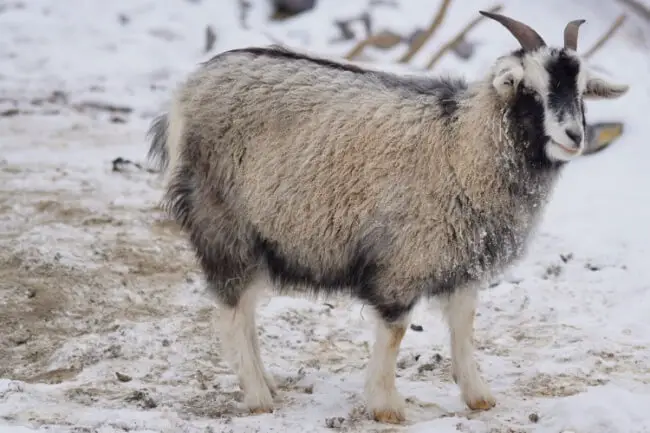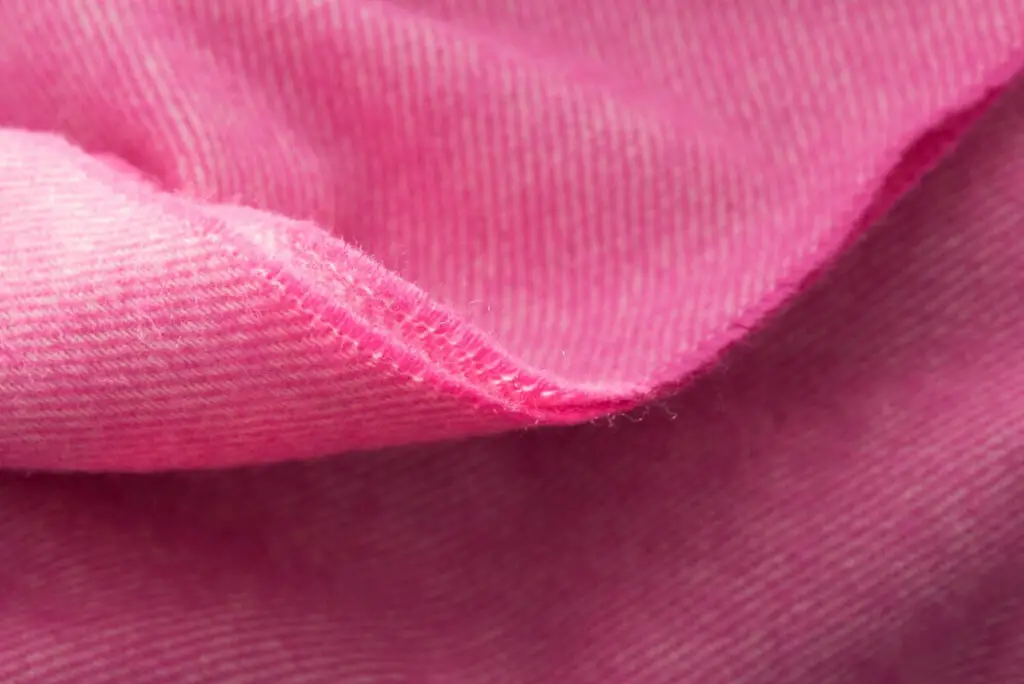Wool and cashmere are two of the most sought-after textiles for making warm luxurious fabrics. With these two competing, it’s hard to know which one is better. So, what are the big differences between wool vs cashmere?
Cashmere is very light, it’s very warm, insulating, and doesn’t contain lanolin but it’s also very expensive. Merino wool is just as soft and is more durable, cheaper, and more eco-friendly than Cashmere.
That brief overview is not nearly enough information to know everything you need to about cashmere and wool, keep reading to learn more about these natural fibers.
What is Cashmere?

Cashmere is the hair of cashmere goats and is produced by various breeds of cashmere goats.
According to CNN, about 40% of the world’s cashmere supply comes from inner Mongolia. The other main producers of cashmere are China, Iran, and Afghanistan.
Cashmere goats produce two layers of hair, the outside layer is called guard hairs and are thick coarse fibers that protect the goat during harsh winters. The second layer is the soft underlayer of hair produced to stay warm in the winter, this soft underlayer is the cashmere wool.
Unlike wool, most cashmere is not sheared off the animal because then you also have all of the undesired guard hairs in the mix.
To avoid this, the fiber is hand-brushed off the goat each spring when the goats begin to molt. Some guard hairs will still be mixed in but not as many as if it was sheared.
The process of brushing out the goats to get the cashmere fiber is one reason why cashmere is more expensive than other fibers.
Once the fiber is harvested, the soft fibers have to be separated from any guard hairs that were mixed in when the goat was brushed. This process is usually done by machine but the added work again increases the expense of cashmere.
Now that you know where cashmere comes from, let’s talk about the differences between cashmere and merino wool.
Cashmere vs Merino Wool
Now I know there are a ton of different types of wool, but for this comparison, I’m going to focus on Merino wool.
Merino wool is the most popular type of wool in the world of natural textiles and it’s also considered a luxury fiber. This is why it’s the best wool to compare to cashmere.
Let’s get into it.
Weight
One of the key differences between wool and cashmere is the weight.
The lightness of cashmere is one of its best characteristics, which is why it gets used a lot in luxury textiles. This lightness gives the fabric a drape that mimics silk.
Merino wool is also light (lighter weight than some other sheep wool) but the individual fibers are denser than those of cashmere.
When it comes to weight, cashmere is much lighter than wool.
Warmth
Both wool and cashmere are great insulators which means they trap heat helping you to maintain your body temperature in the winter. But, because cashmere is lighter, it has a better weight-to-warmth ratio.
Cashmere and wool are also good at wicking moisture away from the skin which is great for next-to-skin garments that you want to keep you warm in the winter.
Softness

Cashmere is an extremely soft fiber.
When talking about the softness of animal fibers, the fiber industry uses a metric called micron count. Micron count is just the thickness of the hair measured in microns
For cashmere fibers to be considered true cashmere, the micron count cannot exceed 19 microns. Merino wool fiber has a micron count of 15-25 microns.
For comparison of how soft this is, the average human hair has a micron count of around 70 microns.
In terms of softness, cashmere and merino are about the same although there may be some merino sheep’s wool that’s thicker than cashmere.
Durability
In terms of durability, Cashmere is less durable than Merino wool.
Because cashmere fibers are so fine, they tend to pill when exposed to any kind of friction. This makes them great for undergarments which won’t get exposed to a lot of wear and tear.
Merino wool, on the other hand, is not as prone to pilling. It’s still good for undergarments because of its softness but it’s also good for hats and gloves that will be more exposed to friction.
Itch Factor
Cashmere is usually considered less itchy than wool. This goes back to the micron count of both fibers.
However, this depends on the quality of the cashmere and the quality of the wool. Some cheaper cashmere blends will contain more of the coarse guard hair than the more expensive blends.
A general rule of thumb is the more expensive the cashmere, the more soft and less itchy it will be.
Another factor here is that cashmere does not contain lanolin which some people are allergic to. Lanolin is a naturally occurring waxy substance produced by sheep that helps protect the wool.
If you are usually irritated by lanolin in wool, then cashmere will be a better option than wool.
Cost
Cashmere is much more expensive than wool for several reasons.
First, cashmere is much more labor-intensive to harvest. Cashmere has to be manually brushed off the goat and then any guard hairs have to be separated out.
This is opposed to Merino wool that gets sheared off and no guard hairs have to be removed.
Cashmere goats are also less common than Merino sheep making it more expensive for the rarity of the fiber.
Lastly, combing the cashmere off of one goat produces less fiber than shearing the fleece off of a single sheep.
One Merino sheep produces a fleece weighing about 15 pounds (240oz). Combing one Cashmere goat will produce about a quarter of a pound (4oz) of fiber.
All of these factors increase the value and are why cashmere is one of the most expensive fabrics.
Eco-Friendliness
The last point that we will compare is how eco-friendly each fiber is.
In general, merino wool is more eco-friendly than cashmere.
The Cashmere industry is huge in Central Asia. It’s great for locals who are raising these animals but the pressure to produce more fiber has caused them to over-graze some areas.
This over-grazing has caused many prairie areas (mainly in Mongolia) to be devastated and turn into deserts.
However, there will always be outliers with both, there are some herders who try to prevent the damage their goats could cause.
If you want to know more about the impact of Cashmere goats and what is being done about it, the United Nations Development Programme has a great article about it that you can find here.
Merino sheep do not cause as much of an environmental impact but, some Merino sheep farms are not as ethical as others.
If this is a big concern you have, I recommend researching the individual seller to see if they are practicing eco-friendly and ethical practices for their animals.
How to Care for Cashmere Garments

One of the big questions when talking about Cashmere is how to have proper care for cashmere products.
Shrinking cashmere sweaters would be devastating, so let’s go over how to properly wash and store your cashmere garments.
How to Wash Cashmere
A good option for cashmere garments is to get them professionally dry-cleaned. A professional will make sure your cashmere scarf is well cared for and cleaned correctly.
However, you can wash it yourself, it just requires special care and attention to make sure you don’t ruin it.
Soap
First, you’ll want to get a mild detergent or laundry soap specifically for wool and cashmere.
Some regular detergents have a chemical in them that breaks down proteins which is great for protein-based stains. However, wool, cashmere, and any other animal fiber are protein fibers. So, having a soap that breaks down protein isn’t a good idea.
The type of soap you want is called wool wash. You might be able to find some at the store, but if not you can get this kind on Amazon (Affiliate link, I get a little commission if you use it).
Washing
It’s not a good idea to put your cashmere clothing in your washing machine, you should wash it by hand. This will help prevent felting caused by agitating wet cashmere and wool.
Hand washing your cashmere garment requires extra care to prevent felting. So, fill a sink with cool or lukewarm water and add your wool wash soap.
Gently place your garment into the sink and press it down until it is fully saturated. Let it sit in the sink for no more than 30 minutes.
Then, take your garment out and drain the soapy water. You can squeeze some of the water out but make sure you don’t wring it. That could cause too much friction and felt the Cashmere.
Refill the sink with cool water with no soap and again submerge the garment. Press the garment down into the water but don’t agitate it.
Take the garment out and gently squeeze out the excess water. If the first rinse didn’t get all the soap out, you can rinse in again using the same method.
Drying
Once your cashmere garment is fully rinsed, it’s time to dry it. You always want to air-dry cashmere and wool. The dryer is a recipe for shrunken sweaters and tears of sadness.
Most wool and cashmere garments usually tell you to lay them flat to dry. You can either do this by hanging them across a clothes drying rack or on a towel on a table.
If you use a drying rack, you don’t want to hang the garment by any one spot because it will stretch that portion of fabric out. That’s why you should lay it across the drying rack instead of hanging it on a hanger.
If you choose to dry it by just laying it on a towel, put a towel down on a flat surface and lay the garment on the top. You’ll want to flip your garment over the next day to ensure both sides dry.
For some more information about how to dry wool garments safely, check out my other post.
Now let’s talk about how to store your Cashmere now that you’ve got it nice and clean.
How to Store Cashmere
Now that your Cashmere is clean, it’s time to store it away. These tips can be and should be used for all wool or animal garments, fiber, and yarn, not just cashmere.
You always want to fold your Cashmere items, never hang them. This is because the weight of the garment can stretch out the parts that are under tension, so it’s always better to fold them.
For best results, you’ll want to store your garments in a breathable cotton or canvas garment bag(affiliate link here!). Although, if you happen to have a cedar chest, that’s the best place to store cashmere, wool, alpaca, and mohair.
When you put your garments away, you’ll also want to take action to keep moths away. Cedar wood has natural pest-repellant properties which is why a cedar chest is such a great place to store wool.
But, most people don’t have those just lying around, so you can add a cedar block, a sachet full of cedar chips or lavender, or a wool dryer ball with lavender and cedar essential oils on it.
Cedar and lavender both repel pests like moths so adding them to where you store your garments is a great natural way to keep bugs away.
And now your cozy cold weather garments are ready to wait until they’re needed again.

